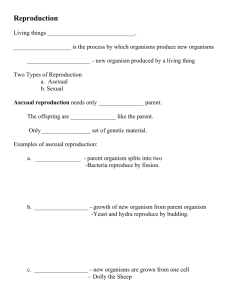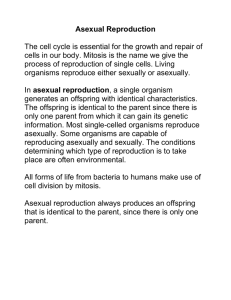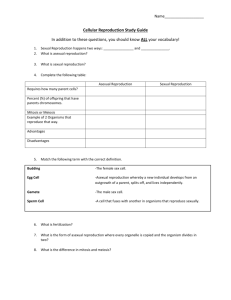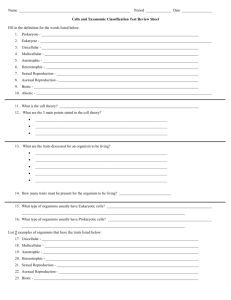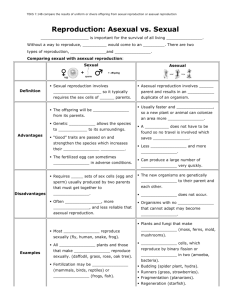Session-4-Reading
advertisement
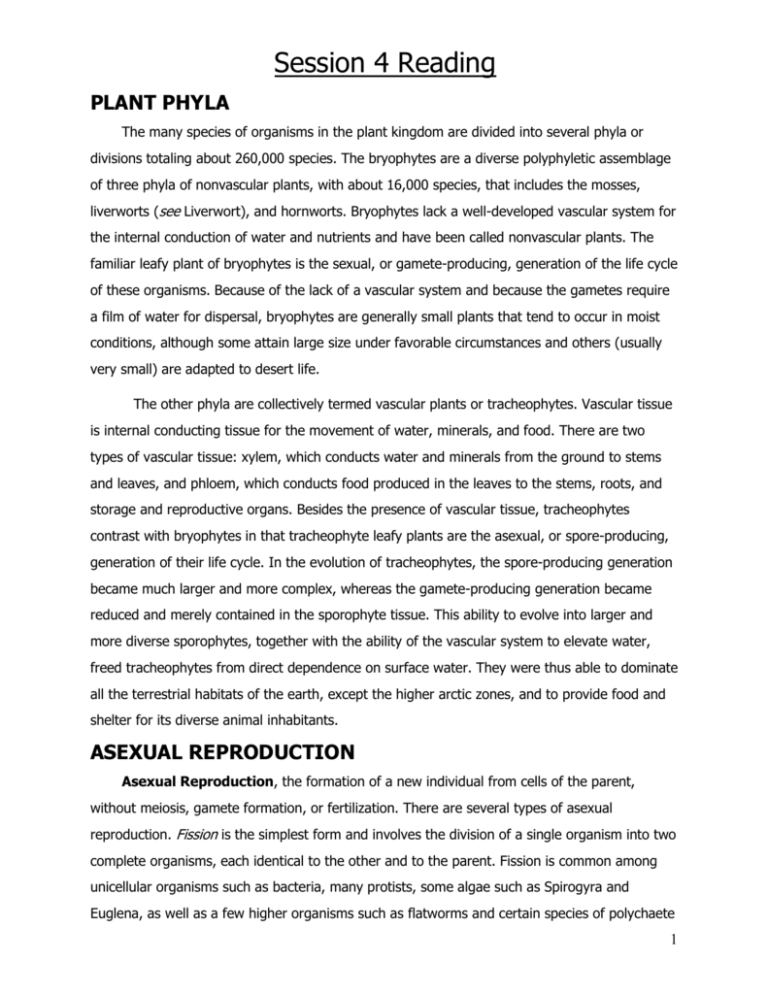
Session 4 Reading PLANT PHYLA The many species of organisms in the plant kingdom are divided into several phyla or divisions totaling about 260,000 species. The bryophytes are a diverse polyphyletic assemblage of three phyla of nonvascular plants, with about 16,000 species, that includes the mosses, liverworts (see Liverwort), and hornworts. Bryophytes lack a well-developed vascular system for the internal conduction of water and nutrients and have been called nonvascular plants. The familiar leafy plant of bryophytes is the sexual, or gamete-producing, generation of the life cycle of these organisms. Because of the lack of a vascular system and because the gametes require a film of water for dispersal, bryophytes are generally small plants that tend to occur in moist conditions, although some attain large size under favorable circumstances and others (usually very small) are adapted to desert life. The other phyla are collectively termed vascular plants or tracheophytes. Vascular tissue is internal conducting tissue for the movement of water, minerals, and food. There are two types of vascular tissue: xylem, which conducts water and minerals from the ground to stems and leaves, and phloem, which conducts food produced in the leaves to the stems, roots, and storage and reproductive organs. Besides the presence of vascular tissue, tracheophytes contrast with bryophytes in that tracheophyte leafy plants are the asexual, or spore-producing, generation of their life cycle. In the evolution of tracheophytes, the spore-producing generation became much larger and more complex, whereas the gamete-producing generation became reduced and merely contained in the sporophyte tissue. This ability to evolve into larger and more diverse sporophytes, together with the ability of the vascular system to elevate water, freed tracheophytes from direct dependence on surface water. They were thus able to dominate all the terrestrial habitats of the earth, except the higher arctic zones, and to provide food and shelter for its diverse animal inhabitants. ASEXUAL REPRODUCTION Asexual Reproduction, the formation of a new individual from cells of the parent, without meiosis, gamete formation, or fertilization. There are several types of asexual reproduction. Fission is the simplest form and involves the division of a single organism into two complete organisms, each identical to the other and to the parent. Fission is common among unicellular organisms such as bacteria, many protists, some algae such as Spirogyra and Euglena, as well as a few higher organisms such as flatworms and certain species of polychaete 1 worms. A similar form of asexual reproduction is regeneration, in which an entire organism may be generated from a part of its parent. The term regeneration normally refers to regrowth of missing or damaged body parts in higher organisms, but whole body regeneration occurs in hydroids (see Hydra), starfish, and many plants. Spores are another form of asexual reproduction and are common among bacteria, protists, and fungi. Spores are DNA-containing capsules capable of sprouting into new organisms; unlike most seeds, spores are produced without sexual union of gametes, that is, reproductive cells. Budding is another method of asexual reproduction in which a group of self-supportive cells sprouts from and then detaches from the parent organism. Unlike eggs or spores, buds are multicellular and usually contain more than one cell layer. Hydroids and sea squirts reproduce by budding. Vegetative reproduction is common among plants and consists of certain parts that grow out from a main parent plant and eventually root and sprout to form new, independent plants. Examples are the runners of strawberries, the tubers of potatoes, and the bulbs of onions. Parthenogenesis is an important means of asexual reproduction in which new individuals are formed from unfertilized eggs. It occurs in some insects, amphibians, reptiles, and birds and in some species of plants. Asexual reproduction may provide a secondary means of multiplying in organisms that ordinarily reproduce sexually. Under certain conditions this may be the only way to reproduce. For example, if there are no other individuals with which to exchange gametes or, in plants, if pollinators are absent. Asexual reproduction demands less time and energy and may be the most efficient way for certain species to reproduce under harsh environmental conditions. Some species switch between asexual and sexual modes of reproduction in an annual cycle so that each takes place at the most favorable time. Examples of this are aphids that reproduce asexually in the summer but sexually in the fall, and water fleas, which have a similar cycle. 2 Organisms that can reproduce asexually are particularly well suited to colonize new habitats because a single individual can establish an entire new population. This is the case in many invasive and weedy species, including many pests introduced from one region to another. An example is the common dandelion, which can reproduce from unfertilized seeds. The offspring of organisms that reproduce asexually are genetically identical to their parents and to each other. Without sexual reproduction, the species cannot benefit from the variability introduced by mixing genes (see Natural Selection). Therefore, evolutionary adaptation to changing environmental conditions may proceed slowly. SEXUAL REPRODUCTION A number of single-celled organisms multiply by conjugation. In this process, which is analogous to fertilization, two similar unicellular organisms fuse, exchange nuclear materials, and then break apart. Each organism then reproduces by fission; occasionally, after conjugation, the participating organisms do not reproduce, the process in these instances seeming merely to revitalize the organisms. Conjugation is the most primitive method of sexual reproduction by which organisms having genetic characteristics derived from two parents are produced. Most multicellular animals and plants undergo a more complex form of sexual reproduction in which especially differentiated male and female reproductive cells (gametes) unite to form a single cell, known as a zygote, which later undergoes successive divisions to form a new organism. The terms fecundation and fertilization are applied to the union of the male and female cells. In this form of sexual reproduction, half the genes, the carriers of inheritable characteristics, in the zygote come from one parent and half from the other parent. See Cell. Many lower multicellular organisms and all higher plants undergo an alternation of generations. In this process, a sexually produced generation alternates with an asexually produced generation. In some organisms that reproduce sexually, a process known as parthenogenesis occurs in which the female sex cell develops without fertilization. In higher animals, individuals of a single species are either male or female, according to whether they produce male reproductive cells or female reproductive cells. The typical male reproductive cell, which is known as a sperm, spermatozoon, or spermatozoan, is a motile cell with a head containing the nucleus and a whiplike tail with which it swims. The typical female reproductive cell, which is known as an egg or ovum, is a rounded cell many times larger than the sperm and containing large amounts of cytoplasm surrounding the nucleus. Plant 3 reproductive cells are roughly similar to animal cells, the male cell being known as the sperm or microgamete and the female cell as the ovum or macrogamete. ADAPTIVE ADVANTAGES OF SEX Many organisms also reproduce asexually (the parent multiplying without prior union), as in the case of bacteria and protozoans, which divide through mitosis (see Cell) into separate individuals. Plants and hydras reproduce asexually by budding. Many other organisms—including plants, the water fleas Daphnia, and some wasps—reproduce by parthenogenesis, in which the unfertilized egg develops into an adult. Such asexual reproduction has the advantage of colonizing great populations of a species in a very short period; indeed, Daphnia and wasps switch from sexual reproduction to parthenogenesis to populate ponds and their nests within the short warm season. Such populations, however, are made up of genetic replicas of the parent, and should some adversity occur in the environment, the entire population or species risks extermination. Although sexual reproduction is slower and less direct, it holds the greater advantage of creating a wide diversity of individuals, each of a slightly different genetic makeup. During meiosis, or the formation of sex cells, the double (diploid) set of chromosomes, which appears in every cell of the adult, is randomly reduced to a single (haploid) set in the gamete. When this single set is united with that of the other gamete in fertilization, the genes are again shuffled, so that no offspring is an exact copy of the parent. If little or no change occurs in the environment, the offspring most resembling the parents will be most able to adapt and procreate; if a major change occurs in the environment, some of the offspring that deviated from the parents may be favored. The role of sex in perpetually re-assorting parental genes is a fundamental mechanism of natural selection and probably became well established long before multicellular organisms first appeared. 4

